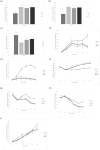Slow and steady wins the race: The behaviour and welfare of commercial faster growing broiler breeds compared to a commercial slower growing breed
- PMID: 32251460
- PMCID: PMC7135253
- DOI: 10.1371/journal.pone.0231006
Slow and steady wins the race: The behaviour and welfare of commercial faster growing broiler breeds compared to a commercial slower growing breed
Abstract
Broilers have been bred for fast growth which has led to welfare problems such as high mortality, lameness and skin lesions. Slower growing breeds are thought to have better welfare but are not as efficient in production. This study investigated welfare, behaviour, production and meat quality of faster growing broilers from three main commercial broiler companies (breeds FA, FB and FC) with a commercially available slower growing breed (Hubbard JA757, S). Four hundred birds of each breed (total 1600 birds) were reared in pens of 50 birds, 8 per breed (total 32 pens). Home pen behaviour was recorded once a week in hourly scan samples to get behavioural time budgets. Welfare Assessments (WA) were done when the average bird weight per breed was 2.2 and 2.5kg. Birds and feed supplied were regularly weighed by pen and Feed Conversion Ratio (FCR) and Average Daily Gain (ADG) were calculated at 2.2kg. Birds were then slaughtered and meat quality measures were taken. S and FC had lower mortality and culls due to lameness (P<0.05 for both). Breeds FA, FB and FC grew faster, ate less feed and had better FCR and ADG (P<0.05 for all). S had scores indicating higher welfare for the majority of WA measures and spent more time active and less time sitting, feeding and drinking than the other breeds (P<0.05 for all). Faster growing breeds had more breast meat and S had more leg meat; although S had better meat quality scores (P<0.05). Overall, S birds have improved welfare in terms of activity and welfare measure scores compared to the other breeds but take longer to reach slaughter weight and are not as efficient in production measures. However if lower mortality and improved meat quality are taken into account, as well as the premium price paid for these birds, slower growing broilers may be a viable commercial option.
Conflict of interest statement
The authors have declared that no competing interests exist.
Figures







References
-
- FAOSTAT. 2017. [cited 14 June 2019]. http://www.fao.org/faostat/en/.
-
- Defra. United Kingdom poultry and meat statistics—February 2018. [cited 27 June 2019]. https://www.gov.uk/government/collections/poultry-and-poultry-meat-stati....
-
- Bessei W. Welfare of broiler: a review. Worlds Poult Sci J. 2006; 62: 455–466.
-
- Meluzzi A, Sirri F. Welfare of broiler chickens. Ital J Amin Sci. 2009; 8: S1: 161–173.
-
- Fraser D, Weary DM, Pajor EA, Milligan BN. A scientific conception of animal welfare that reflects ethical concerns. Anim Welf. 1997; 6: 187–205.
Publication types
MeSH terms
LinkOut - more resources
Full Text Sources
Research Materials

